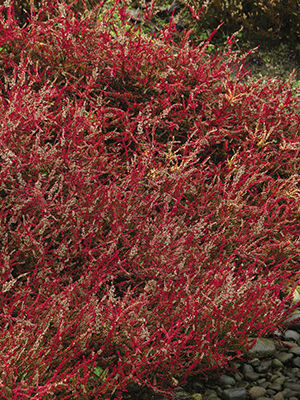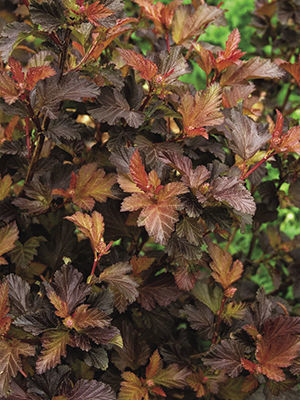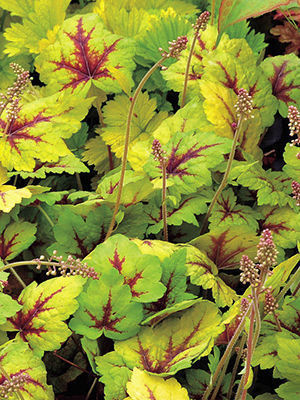1. ‘Firefly’ Heather

Name: Calluna vulgaris ‘Firefly’
USDA hardiness zones: 4 to 7
Size: 18 inches tall and wide
Conditions: Full sun; well-drained soil
This sweet little evergreen has a low-growing, rounded, shrubby habit. Yes, it blooms, but pay little to attention to that. The magical changing colors of the foliage are what make this a stunner in the garden. The spring and summer foliage is a blend of lemon lime, with pale purple flowers in late summer. When the weather gets chilly in fall, the foliage flames to an orange that slowly turns to a deep red in winter. Use ‘Firefly’ heather in meadowlike groupings to create a swath of drama, or tuck it in with perennials to add year-round interest.
2. ‘Center Glow’ Ninebark

Name: Physocarpus opulifolius ‘Center Glow’
Zones: 3 to 7
Size: 6 to 8 feet tall and wide
Conditions: Full sun to partial shade (for best color, plant in full sun); moist, well-drained soil
Just as its name suggests, the foliage of this large shrub seems to glow. Golden, coppery color pools in the center of new leaves, deepening to burgundy from the edges inward as the leaves mature. If you plant ‘Center Glow’ ninebark where it can be left to grow to its informal, vaselike shape, then no heavy pruning will be needed. The drama of dark foliage shows off a planting scheme well, and this attractive ninebark makes an excellent deeply colored backdrop in mixed-color borders. This plant is deciduous, so the interesting peeling bark that gives this plant its common name is revealed in the winter months.
3. ‘Stoplight’ Heucherella

Name: × Heucherella ‘Stoplight’
Zones: 4 to 9
Size: 8 to 10 inches tall and wide
Conditions: Partial shade (protect from hot sun); consistently moist, well-drained soil
Don’t you love the names of some plants? Whoever named this one got it right: Its bright color makes you stop when you see it. Chartreuse is “in,” and this plant is intense with it. A blood red splotch in the center of the leaves gives ‘Stoplight’ heucherella character and definition, and it stops it from becoming just another blur of lime-colored leaves. This is a favorite for use in summer containers; try it with richly contrasting plants, like the deep purple blooms of heliotrope (Heliotropium arborescens and cvs., annual) or with black mondo grass (Ophiopogon planiscapus ‘Nigrescens’, Zones 6–11). In early summer, white “foamy” flowers delicately float on 16-inch-long stems.
4. ‘Nicolas’ Japanese Forest Grass

Name: Hakonechloa macra ‘Nicolas’
Zones: 5 to 9
Size: Up to 18 inches tall and wide
Conditions: Partial shade; loose, rich soil with even moisture
Planting Japanese forest grass is like running a bright highlighter across the ground. This foliage powerhouse is an easy, elegant ground cover. Use it to soften the edges of and light the way along shady pathways. What makes the cultivar ‘Nicholas’ stand out from other varieties of Japanese forest grass is the color change of its leaves. The foliage is a light, luminous green all summer, but in cooler weather, the leaves look as if they’ve been dipped in orange and red.
Sue Goetz is founder and owner of Creative Gardener in Tacoma, Washington, where she offers garden design, coaching, and workshops.
Photos: #1 and #2, Doreen Wynja; #3 and #4, millettephotomedia.com

















Comments
Log in or create an account to post a comment.
Sign up Log in